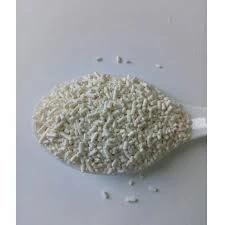
acidity regulator citric acid
Understanding Citric Acid The Versatile Acidity Regulator
Citric acid, a weak organic acid naturally found in citrus fruits, plays a multifaceted role in food preservation and flavor enhancement. As an acidity regulator, citric acid is widely used in various food and beverage products, offering both functional and sensory benefits. This article will explore the significance of citric acid, its applications, and the reasons behind its popularity in the food industry.
What is Citric Acid?
Citric acid (C6H8O7) is a tricarboxylic acid that occurs naturally in many fruits and vegetables, particularly lemons, limes, oranges, and grapefruits. Its discovery dates back to the 18th century, and it is now commercially produced through fermentation processes using mold, particularly Aspergillus niger. Citric acid is a key ingredient in many households, found not only in culinary applications but also in cleaning products, cosmetics, and pharmaceuticals.
Role as an Acidity Regulator
An acidity regulator is a substance added to food products to control the pH level and modify the acidity. Citric acid is valued for its ability to lower pH, thereby enhancing flavors and extending shelf life. It provides a tart taste that complements various dishes and beverages, making it an essential ingredient in processed foods.
In addition to its flavor-enhancing properties, citric acid serves several practical functions
1. Preservation By lowering the pH, citric acid creates an unfavorable environment for the growth of spoilage microorganisms and pathogens. This contributes to the preservation of sauces, dressings, and beverage products.
2. Flavor Enhancement Citric acid adds a sharp, tangy flavor, making it a popular choice in candies, soft drinks, and marinades. It balances sweetness and adds complexity to food profiles.
acidity regulator citric acid

3. Stabilization Citric acid is used to stabilize certain food products by preventing the browning of fruits and vegetables and maintaining the integrity of color and texture in processed foods.
4. Emulsification In dairy and non-dairy products, citric acid can act as an emulsifier, helping to blend ingredients that do not normally mix, such as oil and water, ensuring a smoother texture.
Applications of Citric Acid
The versatility of citric acid has led to its widespread use across various sectors of the food industry. Some common applications include
- Beverages Citric acid is a key component in sodas, fruit juices, and energy drinks, enhancing flavor and preserving freshness. - Canned and Bottled Foods It is often added to canned fruits and vegetables to prevent spoilage and retain color. - Confectionery In candies and gummies, citric acid provides a desirable sourness, appealing to consumers with a penchant for tangy flavors. - Meat and Poultry Products Citric acid is used in marinades and brines for meat, not only for flavor but also for its preservation properties.
Health and Safety Considerations
Citric acid is generally recognized as safe (GRAS) by the Food and Drug Administration (FDA) when consumed in food amounts. It is a well-tolerated ingredient for most individuals, including those with dietary restrictions. However, excessive consumption may lead to gastrointestinal discomfort in some cases.
Conclusion
Citric acid is more than just a sour component in our favorite snacks and beverages; it is a crucial acidity regulator that enhances flavor, preserves food, and stabilizes products. Its natural origin, combined with its versatility, makes it a staple in kitchens and food production facilities around the world. As consumers continue to seek out clean-label ingredients, citric acid stands out as a natural solution, bridging the gap between taste and functionality. Thus, understanding citric acid's benefits not only enhances our appreciation for food but also highlights the importance of this natural acidity regulator in our everyday lives.
-
Pure Sodium Dichloroisocyanurate Dihydrate | Powerful DisinfectantNewsAug.29,2025
-
Industrial Chemicals: Quality & Purity for Every IndustryNewsAug.28,2025
-
Nitrile Rubber Honoring Strict Production StandardsNewsAug.22,2025
-
Aspartame Ingredients Honoring Food Safety ValuesNewsAug.22,2025
-
Fertilizer for Balanced Plant NutritionNewsAug.22,2025
-
Cyanide Gold Processing with High Purity AdditivesNewsAug.22,2025
-
Formic Acid in Textile Dyeing ApplicationsNewsAug.22,2025
Hebei Tenger Chemical Technology Co., Ltd. focuses on the chemical industry and is committed to the export service of chemical raw materials.
-

view more DiethanolisopropanolamineIn the ever-growing field of chemical solutions, diethanolisopropanolamine (DEIPA) stands out as a versatile and important compound. Due to its unique chemical structure and properties, DEIPA is of interest to various industries including construction, personal care, and agriculture. -

view more TriisopropanolamineTriisopropanolamine (TIPA) alkanol amine substance, is a kind of alcohol amine compound with amino and alcohol hydroxyl, and because of its molecules contains both amino and hydroxyl. -

view more Tetramethyl Thiuram DisulfideTetramethyl thiuram disulfide, also known as TMTD, is a white to light-yellow powder with a distinct sulfur-like odor. It is soluble in organic solvents such as benzene, acetone, and ethyl acetate, making it highly versatile for use in different formulations. TMTD is known for its excellent vulcanization acceleration properties, which makes it a key ingredient in the production of rubber products. Additionally, it acts as an effective fungicide and bactericide, making it valuable in agricultural applications. Its high purity and stability ensure consistent performance, making it a preferred choice for manufacturers across various industries.





